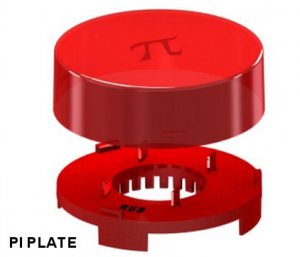Raspberry Pi – Pi Plate **Updated**
Nov 11, 2012 · CommentsRaspberry Pi
Updated on 11/11/12
So after using these for a few months we decided not make them our primary Pi cases. The reality is that if you keep the lid off all the time you are OK, but there is not really enough room inside these to make all the connections you need to make.
For someone that just wants a stand for the Pi to sit on while they work, and leave the board exposed to the air, these are probably great. But if you primarily want a case to enclose the Pi, you should probably look elsewhere.
I could never got the lid to go on with a USB or HDMI cable plugged in. You would have to buy special “L” cables, or adapters which are hard to find.
Original Post
So, as you have seen from my other posts I’ve ordered a Raspberry Pi computer for one of my kids, but last night when we talked about it at dinner, my other kid (4 years old) was so sad that I had not ordered a Raspberry Pi for her, that when my Allied “notification-to-order” email came today I clicked on it intending just to order another Raspberry Pi.
As it turned out, Allied has a lot more accessories for the little computers than Element 14 did. The one that caught my eye most was the “Pi Plate”. It is a cool looking round case with a twist off lid for the Raspberry Pi. I was wondering what I might do about the case aspect, but now I have a good solution. So in addition to ordering another Raspberry Pi, I also ordered two “Pi Plate” enclosures.
Check out the info page about the Pi Plate at Allied.
The “Pi Plate is manufactured by Bud Industries. It’s not a company that I’ve heard of or bought products from before, but it looks like they have a cool product on their hands here. If you want to see the company’s info page about the Pi Plate and it’s sister case the Pi Sandwich you can check them out here. Here is how BudInd describes the two enclosures:
The PI Plate
- This is a round version and consists of a base plate and an easy on/off twist-lock cover
- Well suited for desktop users
- Ideal for users who need frequent access to the GPIO Headers (auxiliary 26 pins)
- Four posts allow snap-in assembly of the PCB
- This version fully encloses all components without the need for any cutouts (Right angle connector may be required for HDMI and USB ports, alternatively you may want to remove the computer from the clips and let it “float” inside the enclosure. Click here for details)
- Centrally located access hub with integral cable management feature ** Raspberry Pi is a trademark of the Raspberry Pi Foundation.
The PI Sandwich
- This is a rectangular version and consists of two identical halves that fit together
- It has windows on four sides for direct access to components
- Windows have built-in slots to accept user supplied cover panels
- Well suited for users who frequently connect and disconnect from the PCB ports
- Optional silicone band will be available in future for covering windows and allowing user to easily create custom cutouts
I’m looking forward to trying out the “Pi Plates” with my kids on their Raspberry Pi computers. I’m also planning some first programming projects for them to do. Any suggestions?
